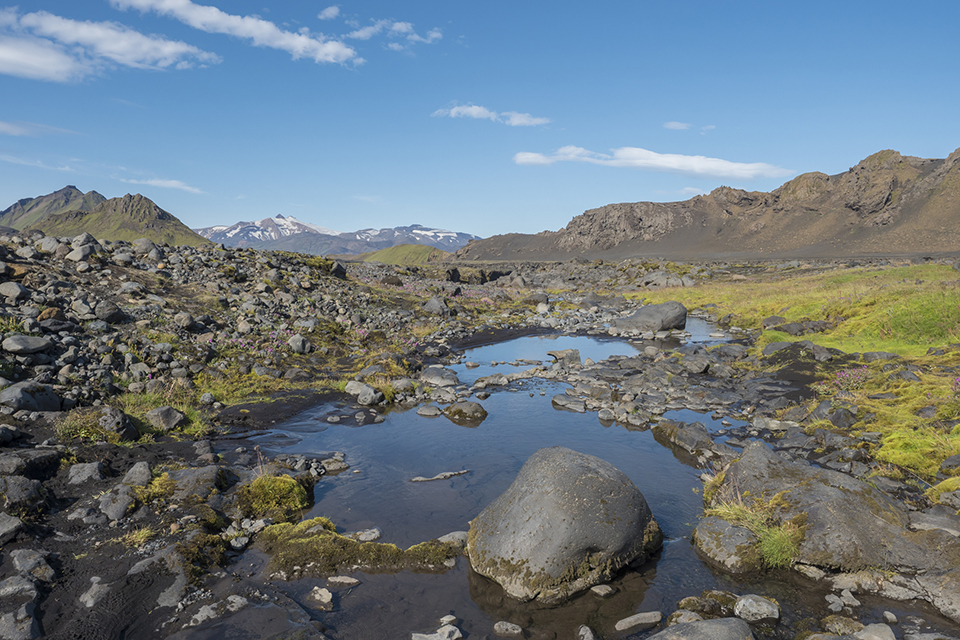Iceland is covered with vast stretches of wilderness. The question is, how is it best protected?
Wilderness is an increasingly rare landscape resource characterized by the IUCN as “protected areas that are usually large, unmodified, or slightly modified, retaining their natural character and influence, without permanent or significant human habitation, and are protected and managed to preserve their natural condition.”Retaining Wilderness Areas” is therefore listed at the top of its 21 action-oriented targets for 2030 in the Convention for Biological Diversity.
Unfortunately, not much true wilderness can be found in present-day Europe. However, Iceland still possesses large tracts of rugged wilderness.
In Iceland, glaciers and ice caps intertwine, while vast sandunes and gravel plains stretch into hills and rugged mountains with their peaks reaching for the heavens. Between them rivers are fed by ancient glaciers, while hot springs breathe life into the land cut through by gorges and valleys. Once forested, the cover is now mainly grass and herbs in summertime.
Unfortunately, the protection is precarious, especially due to threats from renewable energy exploitation that encroach upon Iceland’s unique treasure. Other threats consist of tourism overflow and off-roading in wintertime. “Winter driving off-road over snow and ice remains an issue that requires further attention,” writes Carver and his research team.
Recently, this group of scientists posted a new method to map the icelandic wilderness to secure it from further encroachment, or at least to prevent entrepreneurial activities from being undertaken without public consultations.
This new approach to mapping wilderness is based on internationally recognized methods and customized to suit the unique nature of Icelandic landscapes. The scientists have used spatially explicit models of wilderness attributes that measure human impact from vehicular access, land use, and visible human features, rather than relying on proxy measures such as buffer zones. Seventeen wilderness areas are identified across the Central Highlands and surrounding areas, totaling some 28,470 km2. These are then compared to existing mapping projects, including the EU Wilderness Index.
The character of these areas is described using additional spatial data models on openness, ruggedness, and accessibility from settlements, along with information on mobile phone coverage and grazing patterns.
This is the most detailed mapping of wilderness in Iceland to date and represents an important step towards the formal definition of boundaries for wilderness areas meeting IUCN Category 1b and the Wild Europe Working Definition in Iceland.
Tourism – A Dilemma
Icelandic wilderness is a highly marketed tourism product, intended to offer “primitive” forms of recreation, opportunities to experience solitude, and a chance to find freedom away from the constraints of urban living. In 2004, a study was carried out in Iceland’s Landmannalaugar Wilderness based on 550 questionnaires and 12 in-depth interviews. While satisfaction was high and most tourists experienced the area as “unspoiled” wilderness, they also sought good basic services and infrastructure. In 2004, 20% considered the place overrun. This figure had grown to 33% in 2009.
One such dilemma occurred at Landmannlaugur Wilderness, where there used to be a path between the main center and the local hot spring. Tourists used to have the extra sensory experience of walking through the wetland to the spring. However, twenty years ago, the plants gave way, and the caretakers capitulated, installing a bridge. During the last decades, the number of tourists – and hence impact – on the wilderness has grown.
Cultural and Natural Heritage in the Wilderness
Landmannalaugar is a convenient stepping stone for nature tourists on the way to Vatnajökull. Before reaching the daring gletchers though, a visit to Þjóðveldisbærinn, the so-called Commonwealth Farm is recommended. A reconstructed farm based on the Stöng Farm, the medieval predecessor is believed to have been abandoned after the Hekla eruption in 1104.
The farm opens up into the central hall giving access to the sitting room, the store rooms and the bathrooms. Next to the farm is a reconstruction of the small church, which was excavated in the 80s. Stöngs farm figures in the now lost Gaukur’s saga. Visitors are invited to “see” the Iceland World through the preserved. Gaukur Trandilsson, is reported to have been an exceptionally gentle and brave man and fosterbrother to Asgrimur, who ended up killing him. Gaukur is also mentioned in Njál’s Saga and Íslendingadrápa, and a Runic inscription on the orkeney islands, which read: “These runes were carved by the man who was the most knowledgeable of runes in the west of the sea, using the axe that belonged to Gaukur Trandilsson in the south of the land”. Part of Games of Thrones was filmed at the farm and in the wilderness further inland towards the real wilderness of Iceland, the Vatnajökull.
FEATURED PHOTO:
Fjallabak Nature Reserve in Iceland.© Krystina Henkeova/Dreamstime 161110920
SOURCES:
New Approaches to Modelling Wilderness Quality in Iceland
By Steve Carver, Sif Konrádsdóttir, Snæbjörn Guðmundsson, Ben Carver and Oliver Kenyon
In: Land (2023) Vol. 12 Issue 2,
Adapting to Change: Maintaining a Wilderness Experience in a Popular Tourist Destination
By Anna Dora Saethorsdottir
In: Tourism Today (2004) No 4, pp. 52-65
Managing popularity: Changes in tourist attitudes in a wilderness destination
Dóra Sæþórsdóttir
In: Tourism Management Perspectives (2013) Vol 7, pp 47-58
The Representation of Icelandic Medieval Heritage in Tourism
By Mariko Komaru
Thesis: Faculty of Life and Environmental Science. University of Iceland. 2021
